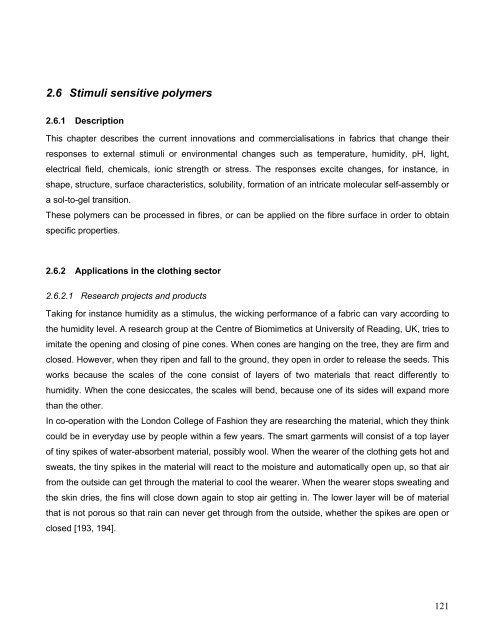Clevertex - Grado Zero Espace Srl
Clevertex - Grado Zero Espace Srl
Clevertex - Grado Zero Espace Srl
You also want an ePaper? Increase the reach of your titles
YUMPU automatically turns print PDFs into web optimized ePapers that Google loves.
2.6 Stimuli sensitive polymers<br />
2.6.1 Description<br />
This chapter describes the current innovations and commercialisations in fabrics that change their<br />
responses to external stimuli or environmental changes such as temperature, humidity, pH, light,<br />
electrical field, chemicals, ionic strength or stress. The responses excite changes, for instance, in<br />
shape, structure, surface characteristics, solubility, formation of an intricate molecular self-assembly or<br />
a sol-to-gel transition.<br />
These polymers can be processed in fibres, or can be applied on the fibre surface in order to obtain<br />
specific properties.<br />
2.6.2 Applications in the clothing sector<br />
2.6.2.1 Research projects and products<br />
Taking for instance humidity as a stimulus, the wicking performance of a fabric can vary according to<br />
the humidity level. A research group at the Centre of Biomimetics at University of Reading, UK, tries to<br />
imitate the opening and closing of pine cones. When cones are hanging on the tree, they are firm and<br />
closed. However, when they ripen and fall to the ground, they open in order to release the seeds. This<br />
works because the scales of the cone consist of layers of two materials that react differently to<br />
humidity. When the cone desiccates, the scales will bend, because one of its sides will expand more<br />
than the other.<br />
In co-operation with the London College of Fashion they are researching the material, which they think<br />
could be in everyday use by people within a few years. The smart garments will consist of a top layer<br />
of tiny spikes of water-absorbent material, possibly wool. When the wearer of the clothing gets hot and<br />
sweats, the tiny spikes in the material will react to the moisture and automatically open up, so that air<br />
from the outside can get through the material to cool the wearer. When the wearer stops sweating and<br />
the skin dries, the fins will close down again to stop air getting in. The lower layer will be of material<br />
that is not porous so that rain can never get through from the outside, whether the spikes are open or<br />
closed [193, 194].<br />
121

















